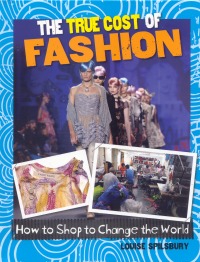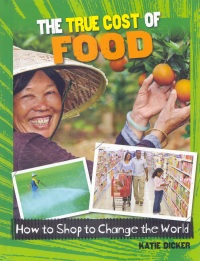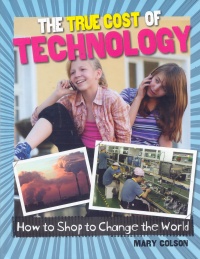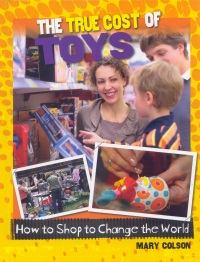| ________________
CM . . . . Volume XXI Number 13 . . . . November 28, 2014
excerpt:
Designed to foster awareness and to spur readers on to social action, the new "Consumer Nation" series consists of four titles, each having four or five chapters. Supporters of events such as We Day will find plenty of food for thought here. The books' contents are very similar; they focus on important issues, such as the supply chain, ethical shopping, the dangerous conditions under which young children work to produce various goods, environmental concerns with regard to the waste that ends up in landfills and waterways, and the ways in which young people can help to alleviate many of the problems associated with the featured topic. Case studies, question and debate boxes, first-hand accounts, maps and charts provide additional information. There are also lists of books, both fiction and nonfiction, and related web sites for further study and possible reader involvement in specific causes. A table of contents, a glossary and an index are also included. There is some incongruence in the books in that the covers, size, layout and format of the books are rather juvenile and "upbeat", but the subject matter is far more serious. (One example is the cover photo of a widely-grinning Asian woman who is picking oranges from a tree, yet the contents of the book belie her exuberance.) The text is suitable for proficient readers who can comprehend the concepts that are presented in the titles without being overwhelmed. In an attempt to appeal to a younger audience, the font style chosen for the introductory paragraphs of each double-page spread is too casual for the subject matter; the remaining text resembles the print from an old typewriter, and the punctuation marks, especially the commas, are so small and faint that they are very difficult to see, thereby causing readers to slow down and re-read specific sentences just to be sure that what they have read makes sense. Another flaw is that there are several facts and statistics presented that are not backed by studies (and there are no citations), and, in one case, some information presented (about genetically modified food) is totally opposite to the view expressed in another Crabtree series. There are abundant colour photographs, all of which are suitably labelled, although some are labelled sideways so that readers have to turn their heads in order to read the labelling. Finally, though the series is aimed at middle school students, it is doubtful that this age group does the food or toy purchasing in the family. Consequently, unless the reader can influence his or her parents, the family's purchasing habits will not change. The True Cost of Fashion discusses the complicated supply chain that begins with the production of raw materials needed to make clothing to the end product when it is in the hands of the consumer. It is estimated that over 50% of American garment factories are sweatshops, and 61% of kids in Asia are employed in sweatshops, often working 16 hours per day. Poor, and often dangerous, working conditions can result in breathing problems, asthma, eyestrain, injury, and even death, as fires can spread quickly on floors filled with dry fabric and thread. Other topics in this title include the environmental impact of producing clothing in terms of energy use, non-biodegradable fabrics, harmful dyes and pesticides, and water pollution and wastage. Readers are encouraged to purchase Fair Trade garments, recycle their old clothing, and be mindful of the cost per wearing before they decide to buy a garment. A tea picker in India earns just two cents for every box of tea sold for $2.78 in the United States. Sadly, his story is just one of many examples of cheap labour and horrible working conditions discussed in The True Cost of Food. Readers will learn about a vulnerable workforce, the exploitation of illegal immigrants and human trafficking, all for the purpose of growing and harvesting food. They will also meet Amit, a bonded labourer living in South West India who has been working from a very young age as a shepherd and farmhand. Thanks to an international development charity, Amit was able to leave the farm and attend school so that his family can have a better life someday. Other children are not so fortunate and are unable to enjoy their childhood because they have to go to work. This title will not only show readers how people can work together to change the lives of exploited workers, but also how they can sustain the world's valuable resources through careful stewardship and by promoting a diet that is safe and does not put a strain on the planet. Sweatshops are not limited to the fashion industry. The production of technological gadgets also takes place in sweatshops where the labour is provided by children too young to work legally. Surprisingly, even major American cities, such as New York, Los Angeles and San Francisco, have sweatshops employing young people. E-waste is becoming the fastest growing sector of both household and business trash, and, with an estimated 99.5% of electronics ending up in landfills, it is no wonder that lead (an astonishing 4 kg of lead is behind a computer monitor) and mercury are leaking into the world's water supply. The True Cost of Technology shows readers how the use of robots in factories and the creation of unions are affecting workers, and how advocate groups and organizations, such as Better World Shopper, through their research into various data sources and the publication of companies' rankings as to ethical practices, help to create improved working conditions for labourers. The toy industry is an $83 billion industry, with China producing over 70% of the world's toys. Once again, in The True Cost of Toys, readers will find more stories about the exploitation of children in sweatshops and the hazardous conditions under which they work. Exposure to toxic paints, glues, dyes and chemicals is just one example. However, some of the stories have happier endings. Consider the Liberian town of Harbel where the workers of a Firestone rubber plantation joined a union and, together with their bosses, banned child labour on the plantation and agreed to reduce the rubber targets by 25%. Even better, the bosses agreed to provide improved schools for all of the children living on the plantation. This title also offers some solutions to reduce the impact of toy production on the environment- making toys from recycled plastic and rubber, using eco-friendly packaging and refraining from using toxic chemicals in toy manufacturing. Without being preachy, this series teaches readers that everyone has a moral obligation to become an ethical shopper. Teachers who are looking for suggestions for an issue-based project will find some good ideas in these titles, but generally speaking, the series will have a limited audience. Recommended. Gail Hamilton is a former teacher-librarian in Winnipeg, MB. Copyright © the Manitoba Library Association. Reproduction for personal use is permitted only if this copyright notice is maintained. Any other reproduction is prohibited without permission.
Next Review |
Table of Contents for This Issue
- November 28, 2014. |



